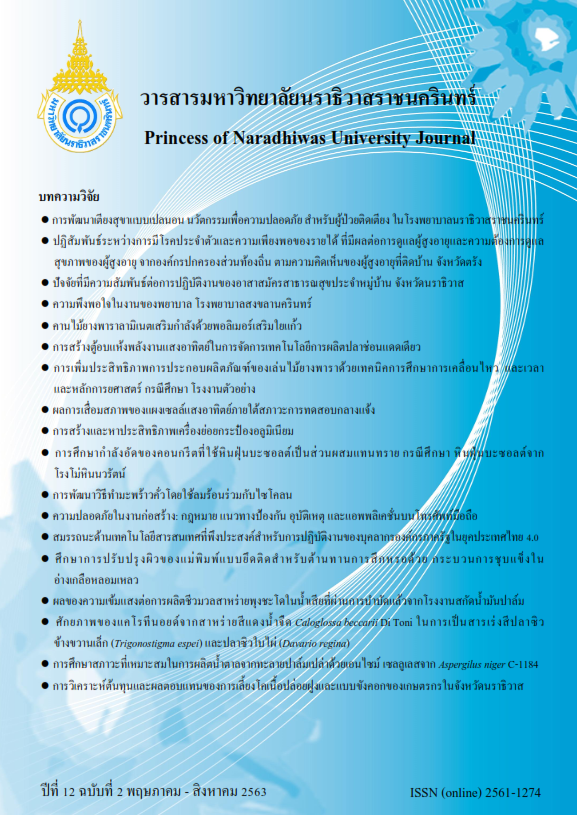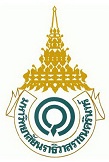การเพิ่มประสิทธิภาพการประกอบผลิตภัณฑ์ของเล่นไม้ยางพาราด้วยเทคนิคการศึกษา การเคลื่อนไหว และเวลา และหลักการยศาสตร์ กรณีศึกษา โรงงานตัวอย่าง
1 คณะวิศวกรรมศาสตร์ มหาวิทยาลัยเทคโนโลยีราชมงคลศรีวิชัย, 2 คณะวิศวกรรมศาสตร์ มหาวิทยาลัยนราธิวาสราชนครินทร์
คำสำคัญ:
การศึกษาการเคลื่อนไหวและเวลา, การยศาสตร์, ของเล่นไม้ยางพารา, ประสิทธิภาพเวลามาตรฐานบทคัดย่อ
งานวิจัยนี้เป็นการศึกษากระบวนการประกอบผลิตภัณฑ์ของเล่นไม้ยางพาราประเภทกล้องถ่ายรูป โดยใช้เทคนิคการศึกษาการเคลื่อนไหวและเวลา และหลักการยศาสตร์ จากการศึกษากระบวนการประกอบผลิตภัณฑ์กล้องถ่ายรูป มีขั้นตอนการประกอบและการเคลื่อนไหวที่ไม่เหมาะสม ทำให้ประสิทธิภาพในการประกอบค่อนข้างน้อย ส่งผลให้พนักงานเกิดความปวดเมื่อยล้าในการทำงานและเสียเวลาในการประกอบ ผู้วิจัยจึงได้นำเทคนิคการศึกษาการเคลื่อนไหวและเวลา เทคนิค ECRS และหลักการยศาสตร์ มาทำการปรับปรุงขั้นตอนการทำงานและออกแบบโต๊ะและเก้าอี้ตามหลักการยศาสตร์ จากการปรับปรุงการกระบวนการประกอบ พบว่าสามารถลดขั้นตอนในการประกอบจากเดิม 8 ขั้นตอน ลดลงเหลือ 7 ขั้นตอน เวลามาตรฐานในการประกอบแบบเดิม 3.254 นาที/ชิ้น เหลือ 2.508 นาที/ชิ้น ซึ่งสามารถลดเวลามาตรฐานในการประกอบลง 0.746 นาที/ชิ้น เพิ่มประสิทธิภาพของกระบวนการประกอบได้ 25.96 เปอร์เซ็นต์ ส่วนท่าทางการทำงานเมื่อประเมินความเสี่ยงทางการยศาสตร์ด้วยวิธีการ RULA และแบบสอบถามความรู้สึกปวดเมื่อยล้า พบว่าสามารถลดระดับความเสี่ยงในการประกอบผลิตภัณฑ์ได้อย่างน่าพอใจ
References
Adnan, A. N., Arbaai, N. A., & ismail, A. (2016). Improvement of Overall Efficiency of Production Line by Using Line Balancing. Journal of Engineering and Applied Sciences, 11(12), 7752-7758.
Barnes, R.M. (1980). Motion and Time Study Design and Measurement of Work. (7th ed.) New York: John Wiley & Sons. USA.
Biswas, S. Chakraborty, A. & Bhowmik, N. (2016). Improving Productivity Using Work Study Technique. International Journal of Research in Engineering and Applied Sciences, 6, 49-55.
Bon, A.T. & Samsudin, S.N.A. (2018). Productivity Improvement in Assembly Line by Reduction Cycle Time using Time Study at Automotive Manufacturer. Proceedings of the International Conference on Industrial Engineering and Operations Management Bandung, Indonesia, March 6-8, 284-291.
Chandra, P.V. (2013). An Effort to Apply Work and Time Study Techniques in a Manufacturing Unit for Enhancing Productivity. International Journal of Innovative Research in Science, Engineering and Technology, 2(8), 4050-4058.
Chitsamran, A. & Kengpol, A. (2014). Productivity Improvements by Using Standard Time and Design for Assembly: A Case Study in a Transformer Manufacturing Plant. IE Network Conference, 30-31 October. Samutprakarn. 467-471. (In Thai).
Department of Industrial Promotion. (2003). Children's Toys Made from Rubberwood. Retrieved from http://www.library.dip.go.th. (in Thai).
Freivalds, A. & Niebel, B. (2013). Niebel's Methods, Standards, & Work Design. New York: McGraw-Hill. USA.
Hassanali, K.N. (2011). A Productivity Model Utilizing a Work Study Approach for Performance Measurement. The Journal of the Association of Professional Engineers of Trinidad and Tobago, 40, 13-25.
Kanjana, C. Supprat, N. Paramart, N. & Sooksaksun, N. (1971). The Application of ECRS Principle for Improving Process Case Study: Soil Production Industry. IE Network Conference, 30-31 October. Samutprakarn. 927-934. (In Thai).
Kanjanapanyakom, R. (2009). Industrial Work Study. Bangkok: Top Publishing. (in Thai).
Kulkarni, P.P.Kshire, S.S. & Chandratre, K.V. (2014). Productivity Improvement Through Lean Deployment and Work Study Methods. International Journal of Research in Engineering and Technology, 3, 429-434.
McAtoammy, L. & Corlett, E.N. (1993). RULA: A Survey Method for the Investigation of Work-Related Upper Limb Disorders. Applied Ergonomics, 24, 91-99.
Meyers, F.E. & Stewart, J.R. (2002). Motion and Time Study for Lean Manufacturing. (3rd ed.), New Jersey, Prentice Hall, USA.
Mishan, N.N. & Tap, M.M. (2015). Increasing Line Efficiency by Using Time study and Line Balancing in a Food Manufacturing Company. Jurnal Mekanikal Di, 38, 32-43.
Ozor, P.A. Chibuike, L.O.O. Orji, O. & Chimaobi, K.O. (2015). Productivity Improvement of Small and Medium Scale Enterprises using Lean Concept: A Case Study of a Bread actory. European Journal of Business and Management, 7, 73-84.
Phichitphajongkij, P. (2018) Improvement of Chassis Production Process of Truck Factory. Engng.J.CMU, 15(2). 55-66.
Rawangwong, S. (2011). Work study. (2nd ed.) Songkhla: Tam Publishing. (in Thai).
Rijiravanich, W. (2000). Work Study: Principle and Case Study. (2nd ed.) Bangkok: (in Thai).
Sanders, M.S., & McCormick, E.J., 1993. Human Factor in Engineering and Design. (7th ed.), McGraw-Hill, California, USA.
Sungkapong, A. & Pochana, K. (2013). Ergonomics and Assessment. Prince of Songkla University. Songkhla. (in Thai).
Teerawatsakul, I. (1999). Motion and Time Study. Department of Industrial Engineering, Faculty of Engineering, Chiang Mai University, Chiang Mai. (in Thai).
Tuntasut, V. Rijiwanit, W. Mahittafowkun, J. & Changsagawet, C. (2000). Work Study. (7th ed.). Chulalongkorn University Publisher. (In Thai).



